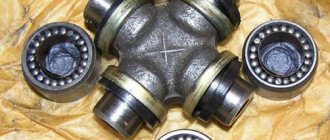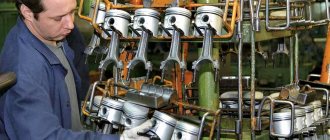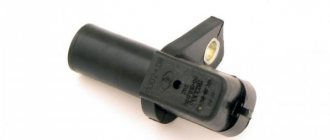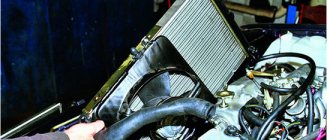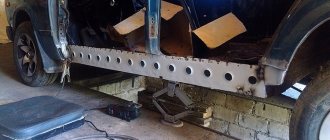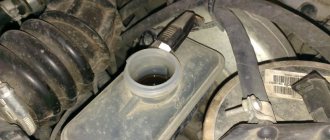Constant circulation of coolant through special channels allows you to maintain a certain temperature regime necessary for normal engine operation.
Failure of the cooling device, leakage of coolant, or insufficient coolant level can ultimately lead to overheating of the engine and, ultimately, to its breakdown. The VAZ 2109 radiator can be repaired after identifying the main reasons that could cause a failure in its effective operation.
Removing the radiator and its subsequent installation in place must be performed on a cold car engine. Before installing a new or repaired radiator, you should check it for leaks.
To do this, just plug the pipes, lower it into a bath of water and supply air with a pressure of 0.2 MPa. If bubbles do not appear on the surface within 30 seconds, then we can assume that the device has passed the leak test. All work on repairing and replacing the radiator can be done independently with your own hands, without the help of a specialist.
What is a car radiator and what is it used for?
A radiator is a part that cools all engine components that heat up during its operation.
The radiator is designed to change the temperature of the heated coolant by air flow. After all, we know well that if the engine does not operate at an optimal temperature, it will simply overheat, boil and fail. Then you will have a lot of trouble on your head. Let's briefly explore the principle of its operation, for a clearer picture.
Heated liquid (antifreeze) passes through the radiator tubes, which is cooled by air flow. Therefore, this important cooling part is installed in its intended place, which is located in the front of the car body, immediately behind the radiator grille, from where the air flow appears when driving. Thus, this very liquid passes through the “honeycomb” of the radiator and cools the heart of the car to its optimal temperature.
Troubleshooting
To find the source of a leak in a stove radiator, pay attention to the following points:
- The primary sign of a leak in the interior heating system is an increased frequency of adding antifreeze to the expansion tank. At the same time, it is impossible to guarantee that the problem is in the radiator itself;
- Examine the condition of the heater valve and pipes;
- If the culprit is a faucet, it is not difficult to determine. If there are no unpleasant sweetish odors inside the cabin and the floor is not covered with traces of coolant, then this is definitely not it. The presence of such signs indicates that the stove tap needs to be replaced;
- The presence of deformations and cracks in the pipes can only be determined by visual inspection. Therefore, dismantling work will have to be carried out;
- Having discarded the options with pipes and tap, there is only one option left - damage to the heater radiator itself.
You should not delay repairing the radiator, as this will first lead to the need to spend extra money on antifreeze. A liter of coolant costs about 100 rubles. And over time, the problem will worsen, antifreeze will fill the interior, begin to corrode the floor covering, and cause a lot of other troubles.
Types of radiators
Radiators differ in case material, its quality and assembly method:
- Prefabricated . The very first and cheapest cooling elements that used a mechanical method, where the components were connected mechanically. No expensive material was used and the work was not particularly difficult.
- Brazed copper . The more expensive analogue of the previous type of spare part is practically no different in operation, but it is many times better quality and stronger than the prefabricated one. The main advantages of this type of radiator are good heat conductivity and the possibility of its repair: damaged areas can be soldered and used further. The price ranges from 1000 to 3000 rubles .
- Aluminum welded . It has a one-piece body and design where the latest welding methods are used. They are the most reliable and durable compared to other types. The obvious disadvantage of an aluminum radiator lies in its material, because, as you know, aluminum is not the best heat conductor, but has better heat transfer. And they cope with this by increasing the area of the radiator itself. The price is almost no different from the price of an aluminum radiator.
Radiator for the cooling system of a carburetor engine VAZ 2108, 2109, 21099
To reduce the temperature of the coolant (coolant) by increasing the area of heat transfer, a radiator is installed in the cooling system of a carburetor engine.
Radiator for the cooling system of a carburetor engine VAZ 2108, 2109, 21099
— Radiator design
The standard radiator for the carburetor engine cooling system of VAZ 2108, 21081, 21083, 2109, 21091, 21093, 21099 is tubular-plate with plastic tanks. The middle part of the radiator consists of several aluminum tubes through which coolant circulates, combined into a frame. Plastic tanks are installed on the sides of the tube frame on rubber seals. The tubes are protected by aluminum plates.
The radiator does not have a filler neck. To fill the liquid, an expansion tank is used, which is connected with a thin hose to the pipe in the upper part of the left radiator tank.
Also, two thick hoses are attached to the two pipes of the left radiator tank (one - the supply pipe goes from the outlet pipe of the block head, the other - the outlet pipe to the lower thermostat reservoir). The hoses are secured with clamps.
The right radiator tank has two threaded holes. One, for installing the cooling system fan switch sensor. Another, for the coolant drain plug from the system. The plug has a “lamb” and can be screwed in and out by hand.
In addition, to prevent the coolant temperature from increasing above normal, an electric fan is installed on the radiator. It is secured inside a metal casing. The casing is attached with bolts and nuts to the radiator tanks. More details about the cooling system fan: “Electric fan of the engine cooling system of VAZ 2108, 2109, 21099 cars.”
— Radiator installation location
On VAZ 2108, 2109, 21099 cars and their modifications, the radiator of the cooling system is installed in the nose of the car to improve its airflow with oncoming air flow.
— Operating principle of the radiator
The radiator of the cooling system is involved in the operation of its small and large circles.
Until the engine is warmed up, the radiator is practically not used, since the thermostat is closed and fluid does not circulate through it. Part of the heated liquid enters only the left radiator tank through the supply hose from the engine cooling jacket (block head outlet pipe). This is the so-called small circle of the cooling system.
After the coolant warms up to more than 87 degrees, the thermostat gradually opens. A large circle of the cooling system comes into operation. The radiator is fully used in it. The coolant enters it through the supply hose from the cylinder block and head and, cooled by the incoming air sweat, goes through the outlet pipe to the lower thermostat reservoir and then into the system.
Depending on the coolant temperature, the thermostat automatically turns the radiator on or off, passing liquid through or bypassing it.
When the coolant temperature increases significantly, when the radiator ceases to cool sufficiently, the electric fan of the cooling system comes into operation. This happens after the contacts in the temperature sensor of the electric fan, in the right radiator tank, are closed. The coolant temperature should exceed 102 degrees.
— Malfunctions of the radiator of the cooling system
There are only two main faults: a coolant leak and a clogged radiator (external and internal). Read more: “The radiator is leaking.”
— Applicability of the radiator
On VAZ 2108, 2109, 21099 cars with a carburetor engine, the radiator 2108-1301012 is used.
Notes and additions
— In addition to aluminum radiators, brass radiators can be installed in the engine cooling system of VAZ 2108, 2109, 21099 cars.
— The radiator of the cooling system of the injection engine 2111 of VAZ 2108, 2109, 21099 cars does not have a sensor for turning on the electric fan. A plug is inserted into the hole under it.
Twokarburators VK - More information on the topic in our VKontakte group, on Facebook Twokarburators FS and on Odnoklassniki - Twokarburators OK
More articles on the carburetor engine cooling system of VAZ 2108, 2109, 21099 cars
— Thermostat of the engine cooling system VAZ 2108, 2109, 21099
— Plug of the expansion tank of the VAZ 2108, 2109, 21099 engine cooling system
— Diagram of the VAZ 2108, 2109, 21099 engine cooling system
— How to replace the pump on a VAZ 2108, 2109, 21099 engine
— Checking the thermostat
— How to remove a tube or hose from a pipe or fitting?
— The fan on the radiator is constantly running, why?
What does the price depend on?
First of all, you need to know that the cost of a radiator depends on the material from which it is made. But that's not all! Since the price also varies depending on the brand and country of manufacture . You need to know this because the types of car radiators depend on the type of engine and battery power.
Basically, copper radiators for a car are suitable if heating of the interior is also necessary. This will serve you for a comfortable ride. And aluminum ones have less weight and the possibility of its repair, as mentioned above.
Only high quality will allow you to use your iron horse comfortably and without problems without the risk of harming other parts, because their breakdown is a great inconvenience not only for your car, but also for you. Therefore, you need to buy a quality product with a guarantee.
Reasons for replacing the device
If during operation the temperature of the coolant increases and the level does not decrease, then most likely there are problems with the radiator. Since the tubes of the device are aluminum and their diameter is small, they cannot be repaired. Today, auto stores offer various coolant-soluble additives and plugging fistulas. However, it should be remembered that their use is a temporary measure. During the trip, the malfunction may occur again and lead to serious consequences.
Most often, radiator leaks occur due to mechanical damage to plastic tanks and cooling tubes during accidents or repair work in the engine compartment. With such a defect, restoration is impractical. In this case, it is recommended to replace the engine cooling radiator with a working one.
To make sure that the device is not sealed, it is immersed in a bath of water, after plugging the holes, and compressed air is supplied. The location and extent of damage are judged by the presence of bubbles that appear. When operating a car in winter and rainy weather, the radiator becomes dirty, especially in the lower part. In this case, the cooling of the liquid deteriorates significantly, which adversely affects the operation of the engine. The aggressive substances present in the dirt react with the material of the tubes, resulting in fistulas.
The use of low-quality antifreeze can not only lead to failure of the radiator, but also cause failure of other elements of the cooling system. It is not recommended to use water as coolant, since scale appears on the inner surfaces of the cylinder block jacket, water pump and radiator tubes. It leads to a deterioration in heat removal, which negatively affects engine performance.
For efficient operation of the coolant, it is necessary to periodically flush it and replace the coolant. This will help avoid breakdowns and extend the life of system elements.
Examples of prices for a part and its installation
Let's look at examples of prices for the part itself and for its installation.
As is already known earlier, a car radiator for a VAZ 2109 costs from 1,500 to 3,000 rubles . The installation itself can cost 200-600 rubles , it depends on the service where you have your car repaired and on the services provided by the service.
Obviously, the price of a radiator for a “higher class” car will itself be higher. For example, a radiator on a Mercedes-Benz A-class will no longer cost 1,500-3,000 rubles, but 4,000-10,000 rubles , and its installation will be a more fragile task and will require more time and effort; accordingly, it will take money to install, perhaps even 2 times more than “nine”.
Choice
When choosing a new radiator for the stove of your VAZ 2109, you should understand what exactly you want to achieve and what budget you have.
Today, consumers are offered two types of units to choose from.
| Radiator type | Peculiarities |
| Aluminum | A relatively inexpensive radiator option, which is characterized by high thermal conductivity. However, such a device cannot be repaired, which is its main drawback. But in practice, repairs are not carried out so often, so few people pay attention to this disadvantage |
| Copper | If necessary and a leak is detected, the copper radiator can be repaired - soldered. Thermal conductivity indicators are slightly higher when compared with aluminum analogues. But at the same time, the price is quite high - both for repairs and for the radiator itself |
Aluminum unit
Due to unprofitability and high cost, most VAZ 2109 owners choose aluminum radiators. But it all depends on your personal decisions and preferences. When actively using a car in harsh winter conditions, a copper radiator is fully justified.
Copper unit
Step-by-step instructions for replacing the radiator
If you have some skills, you can dismantle the radiator yourself. If the car enthusiast does not have repair experience, then it is better to entrust this work to a specialist. Before starting disassembly, you need to prepare a container for used antifreeze. It is not recommended to dump it on the ground, because the liquid is toxic and can harm the environment.
To replace the VAZ-2109 radiator, you must perform a number of sequential actions:
- Disconnect the battery and remove it from the engine compartment.
- Drain the coolant. To do this, unscrew the plugs on the radiator and cylinder block and open the heater tap. Work is carried out on a cold engine.
- On the “nine” with an injector, it is necessary to additionally remove the air filter housing.
- Disconnect the contact blocks from the fan motor and sensor switch and cut off the clamp that secures the wiring harness.
- Remove the throttle linkage bracket attached to the fan casing.
- Disconnect the rubber pipes from the cylinder block jacket, thermostat and steam exhaust hose by removing the fastening clamps.
- Unscrew the nuts securing the radiator to the car body.
- Take it out together with the cooling fan
After this, remove the hoses from the radiator pipes and the remaining equipment.
If the lower mounting pads were removed during disassembly, they must be put back in place, and if there are cracks or loss of elasticity, they must be replaced. At this point, the work on dismantling the defective radiator is considered completed.

